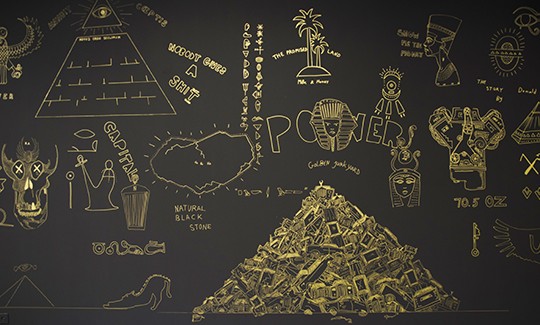Eyal Assulin's visual language explores the culture of prosperity with reference to global socio-economic aspects. His works engage with Eastern culture, featuring a matrix of historical, gender, and artistic status symbols. These are presented in a forthright manner that parodies the bulimic impulse of contemporary consumerism. Assulin expresses a masculine aesthetic outcry reflecting the culture of over-consumption and presenting images that emphasize the perpetual dichotomy between hard labor and abundance.
The exhibition "Majesty" presents a central sculptural installation titled "Majestic Escorts," surrounded by wall ornaments inspired by ancient Egyptian culture. Fourteen golden cats – "Majestic Escorts" – lie in a circle surrounding charcoal stones displaying "Hai" pendants – a local Jewish-Israeli symbol appearing in most of Assulin's works. Alongside images of machines, cars, and skulls, the immortal cat appears as a symbol of fertility, motherhood, and protection of the home in ancient Egypt (MAU in ancient Egyptian).
Assulin's exhibition conveys to the viewer the potential of male power, as described in John Berger's famous book Ways of Seeing, where he distinguishes between male and female social presence. Male presence depends on achieving the power to impact others: "This can take a moral, physical, economic, social, or sexual form, but it is always associated with an external object." As in classical painting, the man appears with the symbols of his power and material achievements, against the background of his castle, his lands, his women and the family members under his control.
The spectacle of power is presented to the viewer as a potential that can be fulfilled. Assulin criticizes the dominant culture by isolating relevant symbolic elements from our cultural world. He presents the extroverted male "tough" ("ars" in Hebrew slang), representing the aesthetics of Moroccan culture, as a kind of visual contrast to the history of Israeli art, based on Western cultures. The gilt "Hai" and the dominant black color appear in his works as an expression of conspicuous wealth and concealed poverty, the manual labor forced on North African immigrants in Israel of the 1950s. The black color enhances the sense of visual abundance, as if symbolizing the idea of "black gold" as a critique of the politicization of wealth in the relations between East and West.
Text: Sharon Toval


